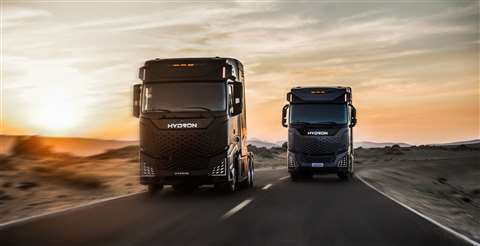Street Smarts: Autonomous trucks need infrastructure
03 October 2022
 Autonomous trucks, such as the hydrogen-powered, autonomous ready trucks from Hydron, will require the infrastucture and support to keep them running on U.S. roads. (Photo: Hydron)
Autonomous trucks, such as the hydrogen-powered, autonomous ready trucks from Hydron, will require the infrastucture and support to keep them running on U.S. roads. (Photo: Hydron)
It’s easy to get caught up in the gee-whiz appeal of seeing new technology developed, evolve and eventually change our world. And it’s equally easy to overlook the drudgery of installing infrastructure to support those new technologies.
For example, if you’ve just built the first-ever boat, then a nice strip of sandy beach will do nicely for getting passengers on and off your vessel. But sooner or later, you’re going to have to build a harbor. Steam locomotives were awe-inspiring metal behemoths when they first appeared in the early 1800s. But they weren’t much use until somebody laid a rail network down. It was the same for the automobile, which worked much better with paved roads and abundant service stations to help it along.
And that’s kind of where trucking is today, with a host of new, zero-emissions vehicles (ZEVs) and battery-electric vehicles (BEVs) approaching their debut in real-word trucking operations around the globe. Initially, the focus was on the benefits and challenges of bringing these new technologies to market. But now, as it has become clear that these various new fuels and powertrains will be able to compete reasonably well with diesel engines, the realization comes that in order to truly transform trucking to a net-zero emissions industry by 2050, multiple infrastructures – with a lot of money behind each one – are going to have to be planned, designed, installed and perfected.
Two-tier problem
But there’s one new technology where I’m not hearing any discussion about infrastructure to support it – and we’re getting close to the time where that needs to be addressed. I’m talking about autonomous trucks and what is really a two-tier infrastructure problem that could hamper the deployment of self-driving trucks.
The first issue is good old-fashioned infrastructure as we normally think of it: roads and bridges. Autonomous trucks absolutely depend on clearly marked, well-maintained lanes, roads, signage and signals to function safely and efficiently. The myriad sensors, cameras and computers that control an autonomous truck aren’t like human drivers. They cannot, for example, “interpret” their way along a road with faded lane markers. A human driver can reason his or her way safely down an unmarked roadway. An autonomous truck has no choice but to pull over and wait for a human driver to take over and get it back on a stretch of road its sensors can handle.
And this is a problem because – and I’m sure you’ve noticed – the U.S. hasn’t exactly done a bang-up job keeping our roads and highways up to snuff over the past 50 years. The Biden Infrastructure Bill, signed into law last November, will go a long way toward fixing many of these issues. But infrastructure as a vital component of operations still isn’t really part of the autonomous truck conversation, yet. And it’s an issue that will have to be meaningfully addressed (and funded) soon.
Human factors
The second infrastructure issue for autonomous trucks that isn’t being addressed is a human one. A lot of people think of autonomous trucks as sort of a “fire and forget” technology. Humans will load the truck. A human logistics manager will key in its destination, and it will roll off on its merry way all by itself.
But trucks require massive amounts of human interaction to safely reach a destination. Drivers, after all, do far more than just drive. They perform pre- and post-trip inspections, fuel the vehicle, perform routine maintenance, check load security and act as a security guard to keep cargo safe.
Who’s going to perform all those tasks – many of which are mandated by federal law – for an autonomous truck working its way across the country?
 Jack Roberts is a Tuscaloosa, Ala.-based independent journalist and licensed commercial driver with more than 20 years’ experience covering the North American and global trucking industries.
Jack Roberts is a Tuscaloosa, Ala.-based independent journalist and licensed commercial driver with more than 20 years’ experience covering the North American and global trucking industries.
I estimate an autonomous truck on a coast-to-coast haul will likely need at least 15 to 20 humans at various points to help it along its journey – for refueling, cleaning and checking sensors, performing inspections and doing minor maintenance. That doesn’t account for any kind of emergency situation, like a blown tire, a fender-bender or a microprocessor flaking out.
Nothing even close to that level of service and support for autonomous trucks exists today.
Planning needed
We know from history that infrastructures tend to form organically over time once a new technology takes root. They often start as private ventures, expand locally, then grow regionally and eventually go national. I have no doubt that will eventually hold true for supporting autonomous trucks.
But it’s something that trucking needs to start discussing and planning for – sooner, rather than later.
POWER SOURCING GUIDE
The trusted reference and buyer’s guide for 83 years
The original “desktop search engine,” guiding nearly 10,000 users in more than 90 countries it is the primary reference for specifications and details on all the components that go into engine systems.
Visit Now
STAY CONNECTED




Receive the information you need when you need it through our world-leading magazines, newsletters and daily briefings.
CONNECT WITH THE TEAM









